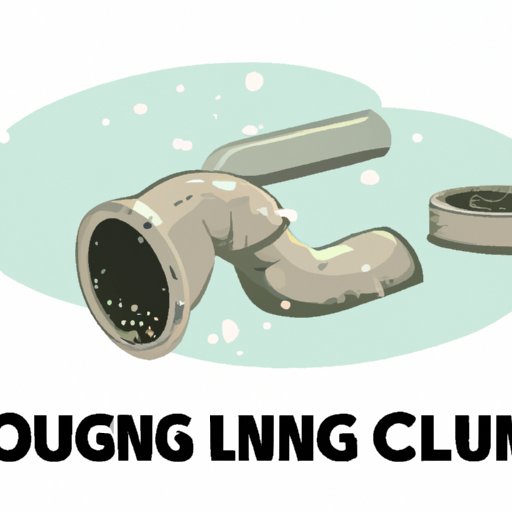
Introduction
Clogged drains are a common, yet frustrating problem faced by many homeowners. From slow-draining sinks to backed-up toilets, a clogged drain can disrupt your daily routine and quickly become a major inconvenience. Fortunately, with the right tools and knowledge, unclogging drains can be a simple and straightforward process. In this article, we’ll provide you with a comprehensive guide on how to unclog different types of drains and offer tips on how to prevent clogs from happening in the first place.
Step-by-Step Guide to Unclogging Drains
Before we delve into the details, it’s important to gather the necessary tools and materials needed to unclog most drains. These include a plunger, drain snake, bucket, rubber gloves, and a screwdriver. Now let’s dive into the step-by-step guide for unclogging different types of drains.
Sink Drains: First, remove any visible debris around the drain opening. Then, fill the sink with enough water to cover the plunger. Place the plunger over the drain and pump it up and down vigorously for 20-30 seconds. If this doesn’t work, try using a drain snake to remove any stubborn clogs.
Shower Drains: Unscrew the drain cover and remove any hair or other debris using a pair of tweezers or needle-nosed pliers. Next, pour a mixture of hot water and baking soda down the drain and wait for 5-10 minutes. Then, flush the drain with hot water. If the clog persists, use a drain snake to remove it.
Toilet Drains: If your toilet is clogged, try using a plunger to unclog it. First, turn off the water supply to the toilet and remove any excess water using a bucket. Then, place the plunger over the drain and push down gently but firmly, then pull up rapidly. Repeat this motion several times until the clog is removed.
Remember to always wear rubber gloves when working with drains to protect your hands from bacteria and other harmful substances.
DIY Methods for Unclogging Drains
While having the right tools is important, sometimes you may not have access to them. That’s where DIY methods come in handy. Here are some of the household items you can use to unclog your drain:
Baking Soda and Vinegar: If you don’t have a plunger, mix 1/3 cup of baking soda with 1/3 cup of vinegar and pour the mixture down the drain. Wait for 30 minutes before running hot water down the drain. This combination can dissolve grease and other substances that may be clogging the drain.
Salt and Hot Water: Pour a half cup of salt down the drain, followed by boiling water. This will dissolve any grease or grime buildup that may be causing the clog.
Wire Hanger: Bend a wire hanger into a hook shape and use it to loosen any debris clogging the drain. Once the clog is removed, flush the drain with hot water.
Tools for Unclogging Drains
A plunger and drain snake are versatile tools that can be used to unclog most drains. Here are some other tools that can be used to tackle different types of clogs:
Manual Drain Auger: This is a flexible cable that can be inserted into the drain and rotated, making it ideal for clearing hair and other debris from sink and shower drains.
Electric Drain Snake: This is a powerful tool that can clear even the most stubborn clogs in toilet drains. It is also useful for any drain that is difficult to access or has a complicated layout.
Causes of Clogged Drains and How to Prevent Them
Clogs can form for many reasons, including hair buildup, food particles, and grease accumulation. Here are some tips on how to prevent clogs:
Dispose of Waste Properly: Make sure to dispose of food scraps and oil in the trash, rather than putting them down the drain. This can prevent FOG (fats, oils, and grease) buildup in your pipes.
Clean Drains Regularly: Use baking soda and vinegar or hot water and dish soap to clean your drains regularly to prevent clogs from forming.
Chemical Methods for Unclogging Drains
If all else fails, chemical drain cleaners can be used to dissolve clogs. However, these can also be harmful to your plumbing pipes and the environment. Here are some popular products to consider:
Bio-Clean: This is an eco-friendly alternative to chemical cleaners that uses natural bacteria and enzymes to dissolve clogs.
Drano: This is a popular chemical drain cleaner that uses a combination of bleach, sodium hydroxide, and aluminum chips to dissolve clogs.
Signs It’s Time to Call a Professional
While DIY methods can often unclog most drains, sometimes the problem requires the attention of a professional plumber. Here are some signs that it’s time to call in the experts:
Recurring Clogs: If you are experiencing clogs on a regular basis, this may be a sign of a more serious issue with your plumbing system.
Sewage Backup: If sewage is backing up into your sinks or toilets, this requires immediate attention from a professional plumber.
Conclusion
Clogged drains can put a damper on your daily routine, but with the right tools and knowledge, they can be easily unclogged. By following the tips and tricks provided in this article, you can prevent clogs from happening and avoid frequent plumbing issues. Remember, if all else fails, don’t hesitate to call in a professional to assist you.





